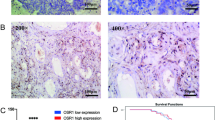Abstract
Dickkopf-1 (DKK1) was known as a negative regulator of the Wnt signaling pathway, which played a crucial role in carcinogenesis. However, its function in human cancers remained elusive. In this study, we aimed to investigate the role of DKK1 in ovarian serous papillary adenocarcinoma (OSC) tumor progression and invasion. Quantitative real-time RT–PCR and Western blot analysis showed that the expression of DKK1 mRNA and protein in 32 OSC tissues were elevated as compared with those in 10 normal ovarian tissues (P = 0.005, P = 0.003, respectively). Immunohistochemical analysis in 178 clinical OSC samples showed that the expression of DKK1 was positively associated with FIGO stage (P = 0.016). Furthermore, the expression of DKK1 protein was positively associated with P-JNK1 protein expression in 178 OSC tissues. DKK1, P-JNK1 and the co-expression of DKK1 and P-JNK1 were all unfavorable prognosis factors for OSC patients (P < 0.0001). DKK1, alone or combined with P-JNK1, was an independent predictor for the 5 year survival (P = 0.015, P < 0.0001, respectively). DKK1 could promote OSC cells invasion and the growth of OSC nude mice xenograft. DKK1 in OSC cells could activate P-JNK1 expression and significantly promote formations of actin filaments and filopodia. Thus, DKK1, alone or combined with P-JNK1, was a novel prognostic predictor for OSC patients and contributed to the invasion of OSC.










Similar content being viewed by others
Abbreviations
- DKK1:
-
Dickkopf-1
- OSC:
-
Ovarian serous papillary adenocarcinoma
- P-JNK1:
-
Phosphorylation of JNK1
- qRT–PCR:
-
Quantitative real-time RT–PCR
- FIGO:
-
Federation International of Gynecology and Obstetrics
- SD:
-
Standard deviation
- TV:
-
Tumor volume
References
Peifer M, Polakis P (2000) Wnt signaling in oncogenesis and embryogenesis—a look outside the nucleus. Science 287:1606–1609
Polakis P (2007) The many ways of Wnt in cancer. Curr Opin Genet Dev 7:45–51
Logan CY, Nusse R (2004) The Wnt signaling pathway in development and disease. Annu Rev Cell Dev Biol 20:781–810
Niehrs C (2006) Function and biological roles of the Dickkopf family of Wnt modulators. Oncogene 25:7469–7481
Krupnik VE, Sharp JD, Jiang C et al (1999) Functional and structural diversity of the human Dickkopf gene family. Gene 238:301–313
Glinka A, Wu W, Delius H et al (1998) Dickkopf-1 is a member of a new family of secreted proteins and functions in head induction. Nature 391:357–362
Wu W, Glinka A, Delius H, Niehrs C (2000) Mutual antagonism between dickkopf1 and dickkopf2 regulates Wnt/beta-catenin signalling. Curr Biol 10:1611–1614
Niida A, Hiroko T, Kasai M et al (2004) DKK1, a negative regulator of Wnt signaling, is a target of theβ-catenin/TCF pathway. Oncogene 23:8520–8526
Gonzalez-Sancho JM, Aguilera O, Garcia JM et al (2005) The Wnt antagonist DICKKOPF-1 gene is a downstream target of β-catenin/TCF and is downregulated in human colon cancer. Oncogene 24:1098–1103
Wirths O, Waha A, Weggen S et al (2003) Overexpression of human Dickkopf-1, an antagonist of wingless/WNT signaling, in human hepatoblastomas and Wilms’ tumors. Lab Invest 83:429–434
Forget MA, Turcotte S, Beauseigle D et al (2007) The Wnt pathway regulator DKK1 is preferentially expressed in hormone-resistant breast tumours and in some common cancer types. Br J Cancer 96:646–653
Yamabuki T, Takano A, Hayama S et al (2007) Dikkopf-1 as a novel serologic and prognostic biomarker for lung and esophageal carcinomas. Cancer Res 67:2517–2525
Yu B, Yang X, Xu Y et al (2009) Elevated expression of DKK1 is associated with cytoplasmic/nuclear beta-catenin accumulation and poor prognosis in hepatocellular carcinomas. J Hepatol 50:948–957
Voorzanger-Rousselot N, Goehrig D, Journe F et al (2007) Increased Dickkopf-1 expression in breast cancer bone metastases. Br J Cancer 97:964–970
Hall CL, Kang S, MacDougald OA et al (2006) Role of Wnts in prostate cancer bone metastases. J Cell Biochem 97:661–672
Shizhuo W, Tao J, Shulan Z et al (2009) The expression and significance of Dickkopf-1 in epithelial ovarian carcinoma. Int J Biol Markers 24:165–170
Torres MP, Ponnusamy MP, Lakshmanan I et al (2009) Immunopathogenesis of ovarian cancer. Minerva Med 100:385–400
Harrison ML, Jameson C, Gore ME (2008) Mucinous ovarian cancer. Int J Gynecol Cancer 18:209–214
Gómez-Raposo C, Mendiola M, Barriuso J et al (2010) Molecular characterization of ovarian cancer by gene-expression profiling. Gynecol Oncol 118:88–92
Jarboe JS, Johnson KR, Choi Y et al (2007) Expression of interleukin-13 receptor α2 in glioblastoma multiforme: implications for targeted therapies. Cancer Res 67:7983–7986
Hao XP, Pretlow TG, Rao JS et al (2001) Beta-catenin expression is altered in human colonic aberrant crypt foci. Cancer Res 61:8085–8088
Endo Y, Beauchamp E, Woods D et al (2008) Wnt-3a and Dickkopf-1 stimulate neurite outgrowth in Ewing tumor cells via a Frizzled3- and c-Jun N-terminal kinase-dependent mechanism. Mol Cell Biol 28:2368–2379
Xia Y, Karin M (2004) The control of cell motility and epithelial morphogenesis by Jun kinases. Trends Cell Biol 14:10–94
Friedl P, Wolf K (2003) Tumour-cell invasion and migration: diversity and escape mechanisms. Nat Rev Cancer 3:362–374
Wang W, Goswami S, Lapidus K et al (2004) Identification and testing of a gene expression signature of invasive carcinoma cells within primary mammary tumors. Cancer Res 64:8585–8594
Seoud M, Salem Z, Shamseddine A et al (1999) Papillary serous carcinoma of the ovary following prolonged tamoxifen treatment. Eur J Gynaecol Oncol 20:237–239
Vivas-Mejia P, Benito JM, Fernandez A et al (2010) c-Jun-NH2-kinase-1 inhibition leads to antitumor activity in ovarian cancer. Clin Cancer Res 16:184–194
Acknowledgments
This article was supported by national nature science fund of China (No. 30973191).
Author information
Authors and Affiliations
Corresponding author
Rights and permissions
About this article
Cite this article
Wang, S., Zhang, S. Dickkopf-1 is frequently overexpressed in ovarian serous carcinoma and involved in tumor invasion. Clin Exp Metastasis 28, 581–591 (2011). https://doi.org/10.1007/s10585-011-9393-9
Received:
Accepted:
Published:
Issue Date:
DOI: https://doi.org/10.1007/s10585-011-9393-9




